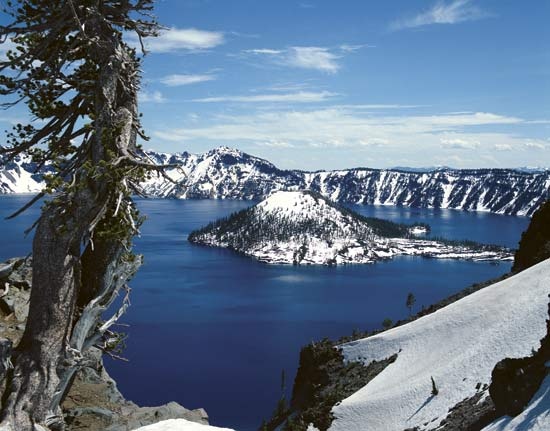caldera
geology
Spanish“cauldron”
 large bowl-shaped volcanic depression more than one kilometre in diameter and rimmed by infacing scarps. Calderas usually, if not always, form by the collapse of the top of a volcanic cone or group of cones because of removal of the support formerly furnished by an underlying body of magma (molten rock). Often this collapse is of a composite cone that rapidly emptied the underlying magma reservoir by voluminous eruptions of pumice and pumiceous ash. At the end of the eruptions, the top of the mountain has disappeared, leaving an immense hole in its place. It once was believed that the top of the mountain had been blown away by the explosions, but studies showed that only a little of the old rock was thrown out and the rest had dropped down into the void. Subsequent minor eruptions may build small cones on the floor of the caldera, which may still later fill up with water, as did Crater Lake in Oregon.
large bowl-shaped volcanic depression more than one kilometre in diameter and rimmed by infacing scarps. Calderas usually, if not always, form by the collapse of the top of a volcanic cone or group of cones because of removal of the support formerly furnished by an underlying body of magma (molten rock). Often this collapse is of a composite cone that rapidly emptied the underlying magma reservoir by voluminous eruptions of pumice and pumiceous ash. At the end of the eruptions, the top of the mountain has disappeared, leaving an immense hole in its place. It once was believed that the top of the mountain had been blown away by the explosions, but studies showed that only a little of the old rock was thrown out and the rest had dropped down into the void. Subsequent minor eruptions may build small cones on the floor of the caldera, which may still later fill up with water, as did Crater Lake in Oregon.Other depressions, of markedly angular, irregular outline, also occur in volcanic districts and commonly are even larger than calderas. Their angular outlines and particularly angular reentrants (indentations) around their edges indicate that their shape is governed by preexisting tectonic structures (produced by movements of the Earth's crust), such as joints and faults in the underlying older rocks. They therefore are referred to as volcano-tectonic depressions. Their collapse also appears to be at least partly related to the rapid extrusion of large amounts of lava. Examples are the Rotorua-Taupo Basin in New Zealand and the basin of Lake Toba (Toba, Lake) in Sumatra.
- spadefish
- spadefoot toad
- spades
- spaghetti
- spahi
- Spahn, Warren
- Spain
- Spain, flag of
- Spalacotherium
- Spalatin, Georg
- Spalding, A.G.
- Spalding, Albert
- Spalding, Henry Harmon
- Spalding, Mother Catherine
- Spallanzani, Lazzaro
- spallation
- spam
- Spandau
- spandrel
- Spangenberg, August Gottlieb
- spaniel
- Spanish-American War
- Spanish Civil War
- Spanish Fork
- Spanish lace